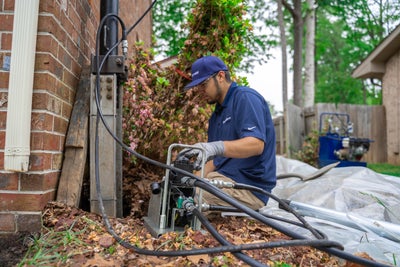Understanding Structural Stability: A Complete Guide to Foundation Repair

Your home’s foundation is its most important structural element. It supports the entire building, keeping walls, floors, and ceilings aligned and secure. Over time, even the most well-built foundations can develop issues due to a variety of environmental, material, and human-related factors. When this happens, foundation repair becomes an essential process to maintain your home’s safety and integrity.
Many homeowners don’t notice foundation problems until the damage is already extensive—or costly. That’s why understanding the signs, causes, repair methods, and long-term benefits of acting early can make a significant difference. This comprehensive guide will walk you through everything you need to know about repairing your foundation, so you can make informed decisions and protect your home for the future.
Why Your Foundation Matters More Than You Think
The foundation isn’t just a slab of concrete beneath your feet. It’s a complex system designed to distribute the weight of your home evenly to the ground below. When it’s working as it should, you don’t think about it. But when issues arise, the consequences can be widespread, affecting both the aesthetics and safety of your property.
Here’s why a strong, stable foundation is essential:
- Structural Safety: It prevents the home from settling unevenly, which can cause cracks in walls, floors, and ceilings.
- Property Value: A damaged foundation can reduce a home’s market value significantly.
- Pest and Moisture Control: Cracks and shifts can allow water, insects, and rodents to enter the structure.
- Energy Efficiency: Gaps in the foundation can allow air leaks that increase heating and cooling costs.
Because the consequences of a compromised foundation can ripple throughout the entire home, it’s crucial to spot signs of trouble early and consider professional foundation repair as soon as possible.
Common Causes of Foundation Damage
Before diving into how to fix a foundation, it’s important to understand why damage happens in the first place. Some of the most common causes include:
1. Soil Movement
The soil beneath your foundation plays a huge role in its stability. Expansive soils (such as clay) can expand and contract dramatically with changes in moisture, leading to pressure that can crack or shift the foundation.
2. Poor Drainage
Improper water management around the home can cause soil erosion or hydrostatic pressure buildup, both of which can damage foundations over time.
3. Tree Roots
Large trees planted too close to the home may cause problems as roots grow underneath the foundation, sucking moisture from the soil and creating instability.
4. Improper Construction
If the foundation was not constructed properly from the start—using low-quality materials or skipping reinforcement steps—it’s more susceptible to damage down the line.
5. Plumbing Leaks
Water from leaking pipes under the foundation can saturate the soil, cause erosion, and contribute to settling or cracking.
Signs You May Need Foundation Repair
Foundation problems often start subtly, but the symptoms can escalate quickly. Here are some of the most common warning signs:
- Cracks in walls or ceilings, especially above windows or doors
- Sticking doors and windows that no longer close properly
- Uneven or sloping floors
- Visible gaps between walls and floors or ceilings
- Cracks in the foundation itself
- Water pooling around the base of your home
- Separation in exterior brickwork or siding
If you notice one or more of these signs, don’t ignore them. A professional inspection can determine whether foundation repair is necessary—and what kind of work will be involved.
Types of Foundation Repair Solutions
Foundation issues vary widely depending on the home’s design, soil conditions, and extent of the damage. Here are the most commonly used methods to address foundation problems:
1. Piering (or Underpinning)
This involves driving steel or concrete piers deep into the ground under the foundation. Once the piers hit stable soil or bedrock, the foundation is lifted and stabilized.
- Best For: Homes with serious settling issues
- Pros: Long-term stability, especially in shifting soils
- Cons: More expensive and invasive
2. Slab Jacking (Mudjacking)
A process where grout or foam is pumped under a sunken concrete slab to lift it back into place.
- Best For: Concrete slab foundations or patios with minor settling
- Pros: Quick and less disruptive
- Cons: Not ideal for heavy or large structures
3. Sealants and Epoxy Injections
Used to fill small cracks in the foundation and prevent water intrusion. This is a more cosmetic solution for non-structural cracks.
- Best For: Minor cracks or leaks
- Pros: Affordable and quick
- Cons: Doesn’t address the root cause of structural issues
4. Soil Stabilization
Improves the load-bearing capacity of soil under the foundation using chemical treatments.
- Best For: Loose or unstable soils
- Pros: Prevents further damage
- Cons: Typically used in conjunction with other repairs
The Foundation Repair Process
Understanding the general workflow for foundation repair can help homeowners feel more confident and informed. While every job is unique, the typical process includes:
Step 1: Inspection and Assessment
A foundation specialist will conduct a thorough inspection, using tools such as laser levels, soil testing, and structural assessments. The goal is to understand the extent of the damage and identify the cause.
Step 2: Recommendation and Estimate
Once the issue is identified, the repair team will suggest the most appropriate solution and provide a detailed cost estimate, including labor, materials, and timelines.
Step 3: Permits and Planning
Depending on local regulations and the scale of the job, permits may be required before work begins. Planning also involves preparing the site and coordinating equipment.
Step 4: Execution
This could involve excavation around the foundation, drilling piers, injecting materials, or replacing damaged sections. Timelines vary based on the complexity of the repair.
Step 5: Final Inspection and Restoration
Once repairs are completed, the structure is rechecked to ensure proper alignment and stability. Any displaced landscaping or exterior features are restored to their original condition.
Cost Factors for Foundation Repair
The cost of repairing a foundation can range significantly based on the scope and method of repair. Here are the key factors that influence pricing:
- Extent of Damage: Minor cracks may cost a few hundred dollars, while severe settling can cost tens of thousands.
- Type of Foundation: Slab foundations are typically less expensive to repair than pier-and-beam foundations.
- Repair Method: Piering is generally more expensive than mudjacking or sealant injections.
- Soil Conditions: Difficult or unstable soil may require more extensive work.
- Accessibility: If the repair area is hard to reach (e.g., under a finished basement), labor costs may increase.
Getting multiple estimates and choosing a reputable contractor can help ensure you receive fair pricing for quality work.
Preventing Future Foundation Problems
Once your foundation is repaired, it’s essential to protect that investment by taking proactive steps to prevent future damage:
- Maintain Proper Drainage: Keep gutters clear and direct water away from your home’s base.
- Monitor Moisture Levels: Avoid dramatic fluctuations in soil moisture by using soaker hoses during dry spells.
- Control Tree Growth: Plant trees away from the foundation and avoid species with aggressive root systems.
- Schedule Annual Inspections: Catch small issues early with routine checks by a professional.
Choosing the Right Contractor for the Job
When it comes to foundation repair, the contractor you choose makes all the difference. Here’s what to look for:
- Licensing and Insurance: Protect yourself by ensuring they’re properly certified and covered.
- Experience and Specialization: Choose a company that focuses specifically on foundation work, not just general construction.
- References and Reviews: Ask for client testimonials and read online feedback.
- Warranty: A solid warranty reflects the contractor’s confidence in their workmanship.
- Clear Contract: Always get a detailed agreement in writing, covering scope, cost, timeline, and warranty terms.
Final Thoughts
A home’s foundation isn’t something you see every day, but its condition affects nearly everything above it. Recognizing signs of trouble and taking quick action can prevent a minor issue from turning into a major structural crisis. Whether you’re dealing with settling, cracking, or water intrusion, timely foundation repair helps restore safety, stability, and peace of mind.
Investing in your foundation is investing in the long-term health of your home. Don’t wait until the damage is obvious or severe—early intervention is always the smartest move.




